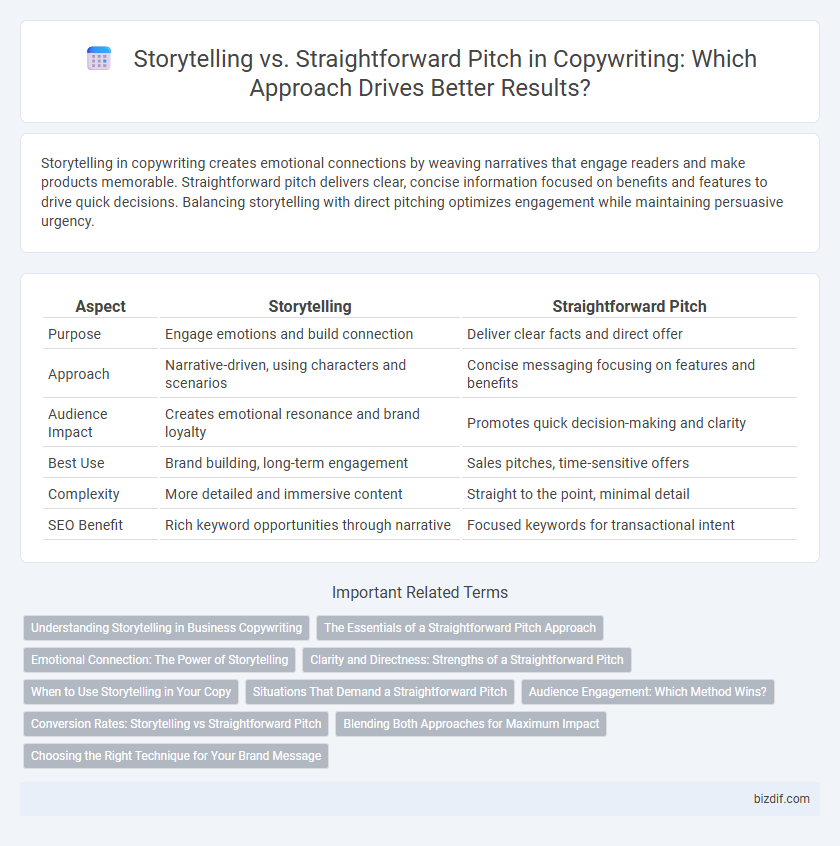Storytelling in copywriting creates emotional connections by weaving narratives that engage readers and make products memorable. Straightforward pitch delivers clear, concise information focused on benefits and features to drive quick decisions. Balancing storytelling with direct pitching optimizes engagement while maintaining persuasive urgency.
Table of Comparison
| Aspect | Storytelling | Straightforward Pitch |
|---|---|---|
| Purpose | Engage emotions and build connection | Deliver clear facts and direct offer |
| Approach | Narrative-driven, using characters and scenarios | Concise messaging focusing on features and benefits |
| Audience Impact | Creates emotional resonance and brand loyalty | Promotes quick decision-making and clarity |
| Best Use | Brand building, long-term engagement | Sales pitches, time-sensitive offers |
| Complexity | More detailed and immersive content | Straight to the point, minimal detail |
| SEO Benefit | Rich keyword opportunities through narrative | Focused keywords for transactional intent |
Understanding Storytelling in Business Copywriting
Storytelling in business copywriting connects brands with audiences by weaving relatable narratives that evoke emotions and build trust. Unlike straightforward pitches that focus solely on product features, storytelling integrates customer experiences and brand values to create memorable messages that drive engagement. This approach enhances brand loyalty and boosts conversion rates by making content more persuasive and authentic.
The Essentials of a Straightforward Pitch Approach
A straightforward pitch communicates the core value proposition clearly and concisely, avoiding unnecessary fluff to maintain the audience's attention. It emphasizes key benefits, specific features, and a direct call to action, which helps prospects quickly grasp the offer and make decisions. This approach suits audiences that prefer efficiency and clarity, making it ideal for B2B sales and time-sensitive scenarios.
Emotional Connection: The Power of Storytelling
Storytelling in copywriting harnesses emotional connection by engaging readers through relatable narratives and vivid imagery, making the message memorable and persuasive. Unlike straightforward pitches that rely on direct facts and features, storytelling evokes empathy and trust, which can significantly boost audience engagement and conversion rates. This emotional resonance transforms potential customers into loyal advocates by creating a compelling brand experience.
Clarity and Directness: Strengths of a Straightforward Pitch
A straightforward pitch excels in clarity and directness, delivering the core message without ambiguity or distraction. This approach minimizes cognitive load, enabling the audience to quickly grasp essential information and make informed decisions. Its concise nature enhances memorability and facilitates immediate action, especially in time-sensitive marketing scenarios.
When to Use Storytelling in Your Copy
Storytelling in copywriting is most effective when aiming to create an emotional connection, build brand identity, and engage audiences by illustrating real-life scenarios or customer experiences. Use storytelling when your product or service benefits from demonstrating a transformation, solving a problem, or conveying values, which helps foster trust and relatability. For high-involvement purchases or brand differentiation, storytelling drives deeper engagement compared to straightforward pitches focused solely on features and benefits.
Situations That Demand a Straightforward Pitch
Situations demanding a straightforward pitch include time-sensitive sales calls or elevator pitches where concise communication is critical. In high-pressure scenarios like investor meetings or cold outreach emails, a direct approach ensures the core message is conveyed quickly and clearly. Prioritizing clarity over narrative structure enhances persuasion when audiences have limited attention spans or urgent decision-making needs.
Audience Engagement: Which Method Wins?
Storytelling captivates audiences by creating emotional connections and memorable narratives that resonate long after the message is delivered. Straightforward pitches appeal to time-conscious consumers seeking clear, concise information with direct benefits. Audience engagement typically peaks with storytelling due to its ability to evoke empathy and foster trust, making it the preferred method in persuasive copywriting.
Conversion Rates: Storytelling vs Straightforward Pitch
Storytelling in copywriting boosts conversion rates by creating emotional connections and engaging readers through narrative, leading to higher audience retention and trust. A straightforward pitch emphasizes product features and benefits directly, which can appeal to time-sensitive customers but often results in lower engagement and reduced conversion rates. Data indicates that storytelling increases conversions by up to 30% compared to purely factual pitches due to enhanced relatability and brand affinity.
Blending Both Approaches for Maximum Impact
Blending storytelling with a straightforward pitch enhances engagement by combining emotional connection and clear value propositions. Effective copywriting leverages narrative to captivate attention while delivering concise, persuasive messages that drive action. This balanced approach maximizes impact by appealing to both the audience's emotions and rational decision-making.
Choosing the Right Technique for Your Brand Message
Storytelling creates an emotional connection by engaging audiences with relatable narratives, ideal for brands seeking to build trust and long-term loyalty. Straightforward pitch delivers clear, concise value propositions, effective for brands emphasizing product features and immediate benefits. Selecting the right technique depends on your brand's voice, target audience, and marketing goals, ensuring your message resonates and drives conversion.
Storytelling vs Straightforward Pitch Infographic

 bizdif.com
bizdif.com